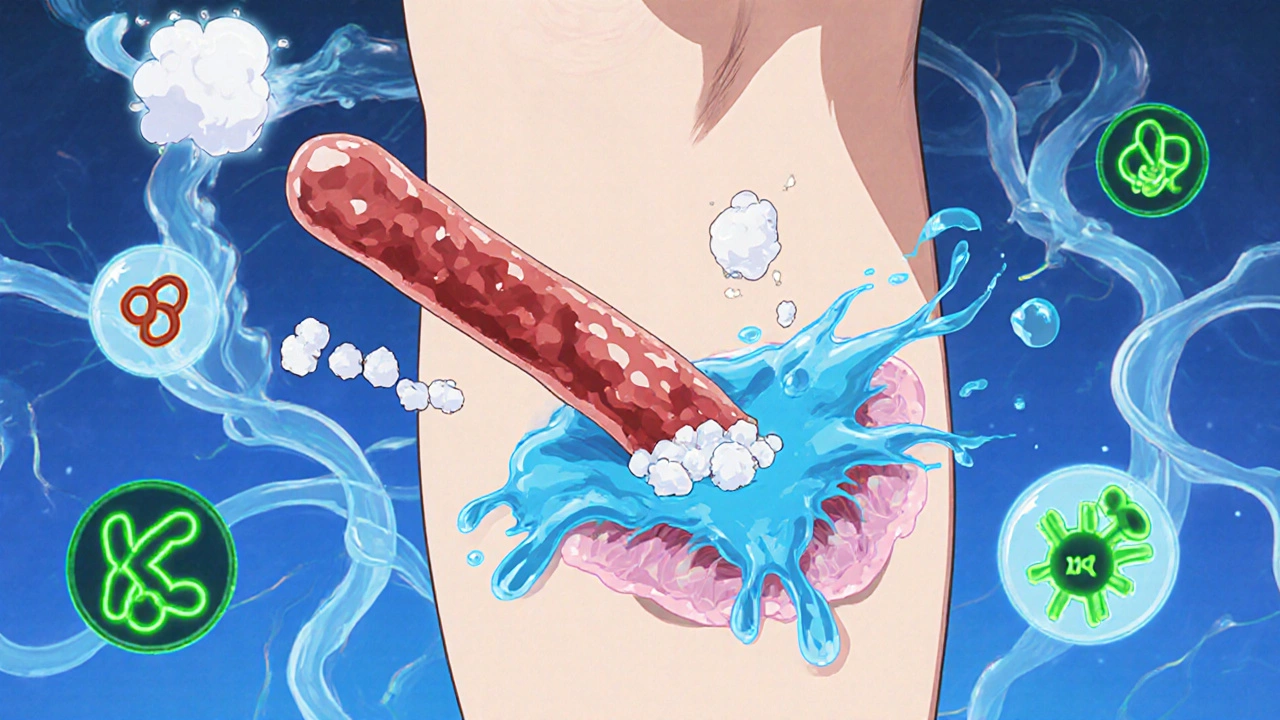Protein Requirement Calculator for Edema Prevention
Protein Calculator
Calculate your daily protein needs to help prevent edema caused by malnutrition.
Recommended Daily Protein Intake
Calculation Details
Why This Matters
When fluid builds up in the body and swelling appears, edema is the accumulation of excess water in the interstitial spaces of tissues. At the same time, malnutrition refers to a state where the body does not get enough nutrients to maintain health. The two often walk hand‑in‑hand, especially in vulnerable populations. This guide explains why that happens, how you can stop it before it starts, and what to do if the swelling has already set in.
Understanding Edema and Malnutrition
Edema isn’t a disease itself; it’s a symptom. It can show up in the legs, ankles, abdomen, or even the face. The underlying cause determines whether it’s a short‑term annoyance or a sign of a serious health issue. Malnutrition, on the other hand, covers a spectrum from mild vitamin deficiencies to severe protein‑energy malnutrition (PEM). When the body lacks protein, albumin levels drop, pulling water out of blood vessels and into surrounding tissue - a classic recipe for edema.
How Malnutrition Triggers Fluid Retention
- Low albumin: Albumin is the main protein that keeps water inside blood vessels. In protein‑deficient diets, albumin production plummets, leading to “hypoalbuminemic edema.”
- Electrolyte imbalance: Deficiencies in potassium, sodium, and magnesium disrupt the body’s fluid regulation, encouraging swelling.
- Lymphatic overload: Malnutrition weakens the lymphatic system, which normally drains excess fluid. When it can’t keep up, fluid pools.
- Heart strain: Chronic malnutrition can weaken heart muscle, sometimes resulting in congestive heart failure, a well‑known cause of peripheral edema.
These mechanisms often overlap. For example, a child with severe acute malnutrition (SAM) may present with both low albumin and electrolyte shifts, creating a perfect storm for generalized edema.
Key Risk Factors and Early Warning Signs
Spotting the link early saves lives. Watch for these red flags:
- Rapid weight gain over a few days, especially in the lower limbs.
- Puffy face or swollen abdomen in a malnourished child or adult.
- Persistent fatigue, shortness of breath, or reduced urine output.
- Visible cracks in the skin that don’t heal, indicating poor protein status.
- History of chronic infections, which can worsen nutrient loss.
When any of these appear alongside a poor diet, it’s time to intervene.

Prevention Strategies
Stopping edema before it starts is largely about securing adequate nutrition and monitoring fluid balance. Below is a practical checklist you can adapt at home, in a clinic, or in a community program.
- Balanced diet: Include high‑quality protein sources (legumes, eggs, dairy, lean meat) at every meal.
- Micronutrient supplementation: Vitamin A, zinc, and iron improve overall tissue health and reduce infection risk.
- Regular growth monitoring: Track weight‑for‑age and height‑for‑age in children; flag sudden changes.
- Hydration control: Encourage water intake but avoid excessive salty soups or processed foods that raise sodium.
- Early infection treatment: Infections increase metabolic demand and nutrient loss, worsening edema risk.
- Community education: Teach families how to recognize swelling and the importance of protein.
Treatment Approaches
Once edema is present, treatment blends nutritional rehab with medical measures aimed at removing excess fluid.
| Intervention | Goal | Typical Duration |
|---|---|---|
| Protein‑rich therapeutic feeding | Raise serum albumin, rebuild lean body mass | 7‑14 days (initial phase) |
| Electrolyte re‑balancing (potassium, magnesium) | Stabilize fluid shifts | 3‑5 days |
| Diuretics (e.g., furosemide) | Promote urine output to reduce swelling | Short‑term, under physician guidance |
| Lymphatic massage or compression therapy | Assist fluid drainage | Daily sessions, 2‑4 weeks |
| Treatment of underlying heart or kidney issues | Address root cause of chronic edema | Variable |
In severe cases, especially with SAM, the World Health Organization recommends a phased approach: stabilization (low‑volume feeds, careful re‑hydration), followed by rehabilitation (high‑energy, high‑protein therapeutic foods). Monitoring serum albumin and electrolytes daily helps avoid sudden shifts that can be dangerous.

Practical Checklist for Caregivers
- Measure mid‑day weight each morning; record changes.
- Inspect ankles and calves for pitting when pressed with a fingertip.
- Ensure the diet provides at least 1.2 g protein per kilogram body weight per day for adults; higher for children.
- Give a daily multivitamin that includes zinc and iron.
- Limit added salt to less than 2 g per day unless a doctor advises otherwise.
- If swelling worsens despite dietary changes, seek medical evaluation for possible diuretic therapy.
Frequently Asked Questions
Can edema be caused by anything other than malnutrition?
Yes. Heart failure, kidney disease, liver cirrhosis, and certain medications can all lead to fluid buildup. The key is to identify the underlying trigger, which may coexist with malnutrition.
How fast can nutritional rehab reduce edema?
In many cases, noticeable reduction occurs within 5‑7 days once protein intake is restored and excess salt is cut. Full resolution may take 2‑4 weeks depending on severity.
Is it safe to use over‑the‑counter diuretics for edema linked to malnutrition?
Only under a doctor’s supervision. Diuretics can worsen electrolyte loss, which is already a problem in malnourished patients.
What role does the lymphatic system play in nutritional edema?
A healthy lymphatic network clears interstitial fluid. Malnutrition weakens lymphatic vessels and reduces the proteins needed for fluid transport, so swelling can persist longer.
Are there specific foods that help pull fluid out of tissues?
Foods rich in potassium (bananas, sweet potatoes), magnesium (nuts, seeds), and high‑quality protein (lean meats, dairy, legumes) support fluid balance and reduce edema.
Understanding the link between edema and malnutrition empowers you to act early, choose the right foods, and seek timely medical help. With the right prevention steps and treatment plan, swelling can be reversed and nutrition restored.

Dante Russello
October 23, 2025 AT 12:07When you first notice a puffy ankle in a child who looks undernourished, the mind instantly jumps to the classic hypo‑albuminemic edema cascade. That cascade, however, is not a single line of cause and effect; it is a web of protein deficiency, electrolyte shifts, and compromised lymphatic drainage. Understanding each strand of that web empowers caregivers to intervene early, before the swelling becomes a persistent burden. First, make sure that every meal contains a source of high‑quality protein-think legumes, eggs, or lean meat-because albumin synthesis hinges on amino acid availability. Second, keep an eye on the salt content of soups and processed foods; excess sodium can overwhelm an already fragile fluid balance. Third, supplement with micronutrients such as zinc and iron, which support tissue repair and immune resilience. Frequent weight checks-ideally at the same time each morning-allow you to spot rapid gains that signal fluid accumulation. A simple pitting test, pressing a fingertip into the shin for a few seconds, can confirm whether the swelling is edematous. If pitting is present and dietary tweaks fail, a physician‑guided diuretic may be warranted, but only after electrolyte levels have been stabilized. Meanwhile, gentle lymphatic massage or compression sleeves can assist the body’s own drainage mechanisms. Remember that chronic malnutrition also weakens the heart muscle, so monitoring for signs of fatigue or shortness of breath is crucial. In severe cases, the WHO’s phased therapeutic feeding protocol-stabilization followed by rehabilitation-has been shown to raise serum albumin within a week. During rehabilitation, aim for at least 1.2 g of protein per kilogram of body weight per day for adults, and proportionally higher for children. Hydration should be adequate but not excessive; plain water is best, while sugary or salty drinks should be limited. Community health workers can distribute ready‑to‑use therapeutic foods, which combine calories, protein, and essential vitamins in a single packet. By integrating these preventive steps into routine care, you not only reduce edema but also set the stage for robust growth and recovery.
James Gray
October 25, 2025 AT 19:40Great checklist-definitely gonna share with the clinic team!
Scott Ring
October 28, 2025 AT 02:13I appreciate the practical vibe of the guide; it feels like something you could hand to a caregiver on the spot. The emphasis on daily weight tracking really hits home for me, since I’ve seen kids slip through the cracks without that simple habit. Also, the reminder about limiting added salt is a gem-many families think a pinch won’t hurt. Overall, this is a solid toolkit for community health workers.
Shubhi Sahni
October 30, 2025 AT 09:47Absolutely, Scott-your points resonate deeply, especially the daily weight check, which serves as an early warning system! In my experience, pairing that with a quick pitting test can confirm edema within minutes, empowering families to act promptly. Moreover, the salt‑restriction advice should be accompanied by practical cooking tips, such as using herbs and spices for flavor. Don’t forget that adequate protein can come from plant sources too; lentils, chickpeas, and soy are excellent, affordable options. By sharing these simple actions, we can bridge the gap between knowledge and everyday practice.
Danielle St. Marie
November 1, 2025 AT 17:20Honestly, most people think a little swelling is no big deal, but that’s just lazy thinking 🙄. If you’re not measuring protein intake every day, you’re practically inviting edema to set up camp. The guide’s checklist is decent, yet it glosses over the fact that many low‑income families can’t afford high‑quality protein 🥦. Sure, supplement the diet, but the real solution is systemic-stop the subsidies that keep processed, salty foods cheap. Until policymakers step up, all these tips are just band‑aid for a broken system 🚩.
keerthi yeligay
November 4, 2025 AT 00:53I see your point, but not all famlies lack protein. Some can grow beans at home cheaply. Education on local food sources helps. Policymakers coud provide subsidies for legumes. Small steps still matter.
Peter Richmond
November 6, 2025 AT 08:27Your suggestions are pragmatic and align with community‑based nutrition strategies. Promoting home‑grown legumes can simultaneously improve protein intake and economic resilience. Policy incentives for small‑scale agriculture would further reinforce these efforts. Implementing such measures requires coordinated action among health officials, agricultural extension services, and local NGOs. In summary, integrating dietary education with structural support offers a sustainable path to reducing edema linked to malnutrition.
Bonnie Lin
November 8, 2025 AT 16:00The guide breaks down the science into easy steps. I especially like the daily weight check tip. Keeping sodium low is simple but effective. Overall a useful resource for anyone caring for at‑risk patients.
sara fanisha
November 10, 2025 AT 23:33Yeah, the weight thing is a game changer. I’ve started using it with my grandma and we see difference fast. Thanks for sharing, really helpful!
Tristram Torres
November 13, 2025 AT 07:07Edema is just swelling caused by fluid. When you don’t eat enough protein, blood can’t hold water. That makes water leak into the tissue. The guide says to add protein and cut salt. Follow those steps and swelling should go down.
Jinny Shin
November 15, 2025 AT 14:40Ah, the tragedy of neglect, painted in simple terms. Yet beneath the plain description lies a battle of cellular integrity. Only through disciplined nourishment can the body reclaim its poise. Thus, the guide is not merely advice-it is a manifesto for revival.